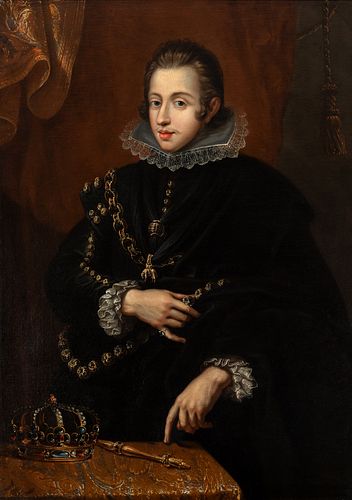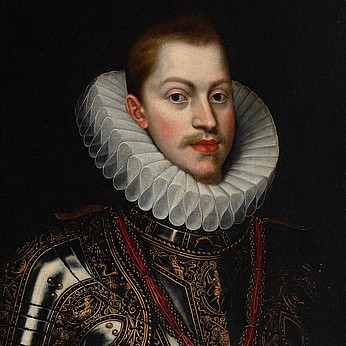GASPAR DE CRAYER (Antwerp, 1584-Ghent, 1669). "Portrait of Philip IV. Oil on canvas. Relined.
Lot 71
About Seller
Setdart Auction House
Carrer Aragó 346
Barcelona
Spain
Setdart Subastas was born in 2004 and is currently the first online art auction in Spain with solidity, prestige and reliability guaranteed by our more than 60,000 users. Setdart has a young, dynamic and enterprising team ready to successfully manage the purchase and sale of art works through custom...Read more
Estimate:
EUR€35,000 - EUR€40,000
$37,634.41 - $43,010.75
Absentee vs Live bid
Two ways to bid:
- Leave a max absentee bid and the platform will bid on your behalf up to your maximum bid during the live auction.
- Bid live during the auction and your bids will be submitted real-time to the auctioneer.
Bid Increments
| Price | Bid Increment |
|---|---|
| EUR€0 | EUR€10 |
| EUR€200 | EUR€25 |
| EUR€500 | EUR€50 |
| EUR€1,000 | EUR€100 |
| EUR€3,000 | EUR€200 |
| EUR€5,000 | EUR€500 |
| EUR€10,000 | EUR€1,000 |
| EUR€20,000 | EUR€2,000 |
| EUR€50,000 | EUR€5,000 |
About Auction
By Setdart Auction House
Nov 24, 2021
Set Reminder
2021-11-24 09:00:00
2021-11-24 09:00:00
America/New_York
Bidsquare
Bidsquare : Old Masters, Day 1
https://www.bidsquare.com/auctions/setdart-auction-house/old-masters-day-1-7873
Setdart Auction House sofia@setdart.com
Setdart Auction House sofia@setdart.com
- Lot Description
GASPAR DE CRAYER (Antwerp, 1584-Ghent, 1669). "Portrait of Philip IV. Oil on canvas. Relined. Measurements: 114 x 80,5 cm; 130 x 99 cm (frame). We are before a portrait of the king Felipe IV that follows the models imposed by the official portrait painting of the time, with the monarch located next to a table where the royal attributes of the mime are found as, for example; the crown and the baton of command, that the king himself points with one of his fingers. In the work we observe an insistence on the detail of Flemish lineage, which can be seen in the brocade of the table cloth, and in the care with which the jewels have been modeled, such as the ring or the toisón hanging from his neck. On the other hand, the composition, as we have already mentioned, does not represent an advance with respect to the model of representation of the monarchs, maintaining the forms of the previous models. Thus, here we see the ideal of the previous generation: the character is represented erect and almost rigid, in an interior of neutral tonality that is hardly endowed with depth with the artifice of a gathered curtain that is, at the same time, a symbol of authority and majesty. Likewise, always following models established in the time of Philip IV, the costume is treated with a meticulousness that reproduces all its details, and the character appears wrapped in clothes that appear rigid. Due to its technical characteristics, this work is aesthetically similar to the work of Gaspar de Crayer, a painter and draftsman of Dutch origin. In 1607 he became a member of the painters' guild in the city of Brussels, where he developed a large part of his career. His painting was highly recognized by the aristocracy of the time, so he was soon closely linked to the court. Gaspar de Crayer's early works include portraits of the kings of Spain and the Spanish governors and officials who were stationed in the Spanish Netherlands, as well as members of the Brussels city council. For example, the equestrian portrait of Don Diego Messia Felipe de Guzmán (Kunsthistorisches Museum, Vienna) was painted by De Crayer in 1627-1628. In addition, from the beginning of his career, de Crayer received commissions for altarpieces to decorate various churches and monasteries around Brussels. It was not until 1635 that Cardinal-Infante Ferdinand of Austria, brother of King Philip IV of Spain and governor of the Spanish Netherlands after the death of his aunt Isabella Clara Eugenia in 1633, made him his first court painter. He later worked as court painter for Archduke Leopold Wilhelm of Austria, who became governor in 1647.
- Shipping Info
-
In-house shipping available. Please inquire at admin@setdart.com.
-
- Buyer's Premium



 EUR
EUR CAD
CAD AUD
AUD GBP
GBP MXN
MXN HKD
HKD CNY
CNY MYR
MYR SEK
SEK SGD
SGD CHF
CHF THB
THB

















